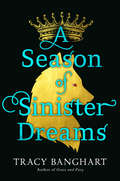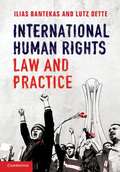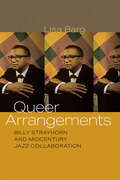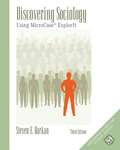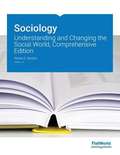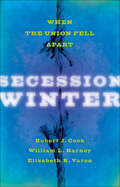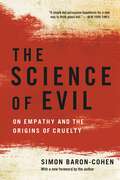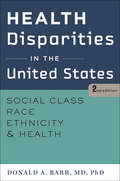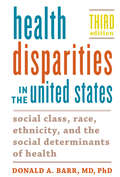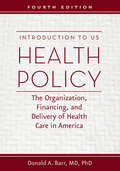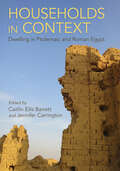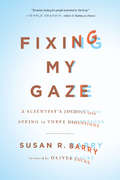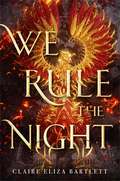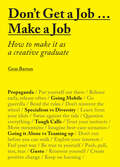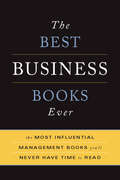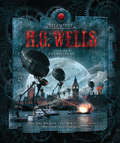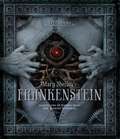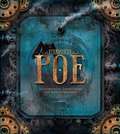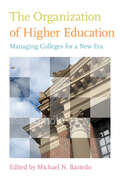- Table View
- List View
A Season of Sinister Dreams
by Tracy BanghartFuryborn meets A Curse So Dark and Lonely in this thrilling fantasy about two powerful girls coming together to protect their beloved kingdom—from the author of Grace and Fury. Annalise may be cousin to the prince, but her past isn't what she claims, and she possesses a magic so powerful it takes all her strength to control it. Evra is a country girl, and has watched as each friend and family member came into their own magic, while hers remains dormant. But everything changes after Annalise loses control of herself and Evra begins experiencing the debilitating visions of a once-in-a-generation clairvoyant meant to serve the crown. Thrown together at court, Evra and Annalise find that they have the same goal: to protect their kingdom from the powerful men who are slowly destroying it. But neither is quick to trust the other—Evra's visions suggest a threat to royal rule, and Annalise worries that her darkest secrets will be revealed. Their magic at odds, the young women circle each other, until the truth must come out. Full of intrigue, romance, and shocking twists, this gorgeously immersive fantasy will keep readers spellbound until the very last page.
International Human Rights Law and Practice (PDF)
by Ilias Bantekas Oette LutzThis innovative textbook explores human rights law from a theoretical and practical perspective. Case studies and interviews with specialists show how theory is applied in real life and discussion questions engage students. The authors' talent for critical analysis and clarification make this an essential student text. Human rights law is a complex but compelling subject that fascinates students but also confuses them. This innovative textbook explores human rights law from a theoretical and practical perspective. Case studies and interviews with specialist practitioners, NGO activists and policy-makers show how theory is applied in real life. The up-to-date coverage includes introductions to important emerging fields such as globalisation, poverty and advocacy. Student learning is supported by questions to stimulate seminar discussion and further reading sections that encourage independent study. The authors' combined expertise, engaging writing style and ability to clarify not simplify ensures that this important new book will become required reading for all students of human rights law.
Risk Management for Enterprises and Individuals
by Etti Baranoff Patrick Lee Brockett Yehuda KahaneThis book is intended for the Risk Management and Insurance course where Risk Management is emphasized. When we think of large risks, we often think in terms of natural hazards such as hurricanes, earthquakes or tornados. Perhaps man-made disasters come to mind such as the terrorist attacks in the U.S. on September 11, 2001. Typically we have overlooked financial crises, such as the credit crisis of 2008. However, these types of man-made disasters have the potential to devastate the global marketplace. Losses in multiple trillions of dollars and in much human suffering and insecurity are already being totaled, and the global financial markets are collapsing as never before seen. We can attribute the 2008 collapse to financially risky behavior of a magnitude never before experienced. The 2008 U.S. credit markets were a financial house of cards. A basic lack of risk management (and regulators' inattention or inability to control these overt failures) lay at the heart of the global credit crisis. This crisis started with lack of improperly underwritten mortgages and excessive debt. Companies depend on loans and lines of credit to conduct their routine business. If such credit lines dry up, production slows down and brings the global economy to the brink of deep recession or even depression. The snowballing effect of this failure to manage the risk associated with providing mortgage loans to unqualified home buyers have been profound, indeed. When the mortgages failed because of greater risk- taking on the Street, the entire house of cards collapsed. Probably no other risk-related event has had, and will continue to have, as profound an impact world wide as this risk management failure. How was risk in this situation so badly managed? What could firms and individuals have done to protect themselves? How can government measure such risks (beforehand) to regulate and control them? These and other questions come to mind when we contemplate the consequences of this risk management fiasco. Standard risk management practice would have identified sub-prime mortgages and their bundling into mortgage-backed-securities as high risk. People would have avoided these investments or would have put enough money into reserve to be able to withstand defaults. This did not happen. Accordingly, this book may represent one of the most critical topics of study that the student of the 21st century could ever undertake. Risk management will be a major focal point of business and societal decision making in the 21st century. A separate focused field of study, it draws on core knowledge bases from law, engineering, finance, economics, medicine, psychology, accounting, mathematics, statistics and other fields to create a holistic decision-making framework that is sustainable and value- enhancing. This is the subject of this book.
Queer Arrangements: Billy Strayhorn and Midcentury Jazz Collaboration (Music / Culture)
by Lisa BargThe legacy of Black queer composer, arranger, and pianist Billy Strayhorn (1915–1967) hovers at the edge of canonical jazz narratives. Queer Arrangements explores the ways in which Strayhorn's identity as an openly gay Black jazz musician shaped his career, including the creative roles he could assume and the dynamics between himself and his collaborators, most famously Duke Ellington, but also iconic singers such as Lena Horne and Ella Fitzgerald. This new portrait of Strayhorn combines critical, historically-situated close readings of selected recordings, scores, and performances with biography and cultural theory to pursue alternative interpretive jazz possibilities, Black queer historical routes, and sounds. By looking at jazz history through the instrument(s) of Strayhorn's queer arrangements, this book sheds new light on his music and on jazz collaboration at midcentury.
Sociology
by Steven E. BarkanThis best selling software-based workbook lets students explore dozens of sociological topics and issues, using data from the United States and around the world. With the workbook and accompanying ExplorIt software and data sets, students won't just read about what other sociologists have done, they will discover sociology for themselves. DISCOVERING SOCIOLOGY will add an exciting dimension to the introductory sociology course.
Sociology: Understanding and Changing the Social World
by Steven E. BarkanThe founders of sociology in the United States wanted to make a difference. A central aim of the sociologists of the Chicago school was to use sociological knowledge to achieve social reform. A related aim of sociologists like Jane Addams, W.E.B. DuBois, and Ida B. Wells-Barnett and others since was to use sociological knowledge to understand and alleviate gender, racial, and class inequality. It is no accident that many sociology instructors and students are first drawn to sociology because they want to learn a body of knowledge that could help them make a difference in the world at large. Steve Barkan's Sociology: Understanding and Changing the Social World is designed for this audience. It presents a sociological understanding of society but also a sociological perspective on how to change society, while maintaining the structure and contents of the best mainstream texts.
Secession Winter: When the Union Fell Apart (The Marcus Cunliffe Lecture Series)
by William L. Barney Robert J. Cook Elizabeth R. VaronPoliticians and opinion leaders on both sides of the Mason-Dixon line struggled to formulate coherent responses to the secession of the deep South states. The Confederate attack on Fort Sumter in mid-April 1861 triggered civil war and the loss of four upper South states from the Union. The essays by three senior historians in Secession Winter explore the robust debates that preceded these events.For five months in the winter of 1860–1861, Americans did not know for certain that civil war was upon them. Some hoped for a compromise; others wanted a fight. Many struggled to understand what was happening to their country. Robert J. Cook, William L. Barney, and Elizabeth R. Varon take approaches to this period that combine political, economic, and social-cultural lines of analysis. Rather than focus on whether civil war was inevitable, they look at the political process of secession and find multiple internal divisions—political parties, whites and nonwhites, elites and masses, men and women. Even individual northerners and southerners suffered inner conflicts. The authors include the voices of Unionists and Whig party moderates who had much to lose and upcountry folk who owned no slaves and did not particularly like those who did. Barney contends that white southerners were driven to secede by anxiety and guilt over slavery. Varon takes a new look at Robert E. Lee's decision to join the Confederacy. Cook argues that both northern and southern politicians claimed the rightness of their cause by constructing selective narratives of historical grievances. Secession Winter explores the fact of contingency and reminds readers and students that nothing was foreordained.
The Science of Evil: On Empathy and the Origins of Cruelty
by Simon Baron-CohenA groundbreaking and challenging examination of the social, cognitive, neurological, and biological roots of psychopathy, cruelty, and evilBorderline personality disorder, autism, narcissism, psychosis: All of these syndromes have one thing in common--lack of empathy. In some cases, this absence can be dangerous, but in others it can simply mean a different way of seeing the world.In The Science of Evil Simon Baron-Cohen, an award-winning British researcher who has investigated psychology and autism for decades, develops a new brain-based theory of human cruelty. A true psychologist, however, he examines social and environmental factors that can erode empathy, including neglect and abuse.Based largely on Baron-Cohen's own research, The Science of Evil will change the way we understand and treat human cruelty.
Health Disparities in the United States: Social Class, Race, Ethnicity, and Health
by Donald A. BarrOutstanding Academic Title, Choice magazineThe health care system in the United States has been called the best in the world. Yet wide health disparities persist between different social groups, and many Americans suffer from poorer health than people in other developed countries. Donald A. Barr's Health Disparities in the United States explores how socioeconomic status, race, and ethnicity interact with socioeconomic inequality to create and perpetuate these health disparities. Examining the significance of this gulf for the medical community, cultural subsets, and society at large, Barr offers potential policy- and physician-based solutions for reducing health inequity in the long term.This popular course book, which has been fully updated, now incorporates significant new material, including a chapter on the profound effects of inequality on child development, behavioral choices, and adult health status. An essential text for courses in public health, health policy, and sociology, the second edition analyzes the complex web of social forces that influence health outcomes in the United States. This book is a vital teaching tool and a comprehensive reference for social science and medical professionals.
Health Disparities in the United States: Social Class, Race, Ethnicity, and Health
by Donald A. BarrOutstanding Academic Title, Choice magazineThe health care system in the United States has been called the best in the world. Yet wide health disparities persist between different social groups, and many Americans suffer from poorer health than people in other developed countries. Donald A. Barr's Health Disparities in the United States explores how socioeconomic status, race, and ethnicity interact with socioeconomic inequality to create and perpetuate these health disparities. Examining the significance of this gulf for the medical community, cultural subsets, and society at large, Barr offers potential policy- and physician-based solutions for reducing health inequity in the long term.This popular course book, which has been fully updated, now incorporates significant new material, including a chapter on the profound effects of inequality on child development, behavioral choices, and adult health status. An essential text for courses in public health, health policy, and sociology, the second edition analyzes the complex web of social forces that influence health outcomes in the United States. This book is a vital teaching tool and a comprehensive reference for social science and medical professionals.
Health Disparities in the United States: Social Class, Race, Ethnicity, and the Social Determinants of Health
by Donald A. BarrThe health care system in the United States has been called the best in the world. Yet wide disparities persist between social groups, and many Americans suffer from poorer health than people in other developed countries. In this revised edition of Health Disparities in the United States, Donald A. Barr provides extensive new data about the ways low socioeconomic status, race, and ethnicity interact to create and perpetuate these health disparities. Examining the significance of this gulf for the medical community and society at large, Barr offers potential policy- and physician-based solutions for reducing health inequity in the long term.This thoroughly updated edition focuses on a new challenge the United States last experienced more than half a century ago: successive years of declining life expectancy. Barr addresses the causes of this decline, including what are commonly referred to as "deaths of despair"—from opiate overdose or suicide. Exploring the growing role geography plays in health disparities, Barr asks why people living in rural areas suffer the greatest increases in these deaths. He also analyzes recent changes under the Affordable Care Act and considers the literature on how race and ethnicity affect the way health care providers evaluate and treat patients.As both a physician and a sociologist, Barr is uniquely positioned to offer rigorous medical explanations alongside sociological analysis. An essential text for courses in public health, health policy, and sociology, this compelling book is a vital teaching tool and a comprehensive reference for social science and medical professionals.
Health Disparities in the United States: Social Class, Race, Ethnicity, and the Social Determinants of Health
by Donald A. BarrThe health care system in the United States has been called the best in the world. Yet wide disparities persist between social groups, and many Americans suffer from poorer health than people in other developed countries. In this revised edition of Health Disparities in the United States, Donald A. Barr provides extensive new data about the ways low socioeconomic status, race, and ethnicity interact to create and perpetuate these health disparities. Examining the significance of this gulf for the medical community and society at large, Barr offers potential policy- and physician-based solutions for reducing health inequity in the long term.This thoroughly updated edition focuses on a new challenge the United States last experienced more than half a century ago: successive years of declining life expectancy. Barr addresses the causes of this decline, including what are commonly referred to as "deaths of despair"—from opiate overdose or suicide. Exploring the growing role geography plays in health disparities, Barr asks why people living in rural areas suffer the greatest increases in these deaths. He also analyzes recent changes under the Affordable Care Act and considers the literature on how race and ethnicity affect the way health care providers evaluate and treat patients.As both a physician and a sociologist, Barr is uniquely positioned to offer rigorous medical explanations alongside sociological analysis. An essential text for courses in public health, health policy, and sociology, this compelling book is a vital teaching tool and a comprehensive reference for social science and medical professionals.
Introduction to US Health Policy: The Organization, Financing, and Delivery of Health Care in America
by Donald A. BarrHealth care reform has been a dominant theme in public discourse for decades now. The passage of the Affordable Care Act was a major milestone, but rather than quell the rhetoric, it has sparked even more heated debate. In the latest edition of Introduction to US Health Policy, Donald A. Barr reviews the current structure of the American health care system, describing the historical and political contexts in which it developed and the core policy issues that continue to confront us today.Barr;€™s comprehensive analysis explores the various organizations and institutions that make the US health care system work;¢;‚¬;€?or fail to work. He describes in detail the paradox of US health care;¢;‚¬;€?simultaneously the best in the world and one of the worst among developed countries;¢;‚¬;€?while introducing readers to broad cultural issues surrounding health care policy, such as access, affordability, and quality. Barr also discusses specific elements of US health care with depth and nuance, including insurance, especially Medicare and Medicaid. He scrutinizes the shift to for-profit managed care while analyzing the pharmaceutical industry, issues surrounding long-term care, the plight of the uninsured, the prevalence of medical errors, and the troublesome issue of nursing shortages. The thoroughly updated edition of this widely adopted text focuses on the Affordable Care Act. It explains the steps taken to carry out the Act, the changes to the Act based on recent Supreme Court decisions, the success of the Act in achieving the combined goals of improved access to care and constraining the costs of care, and the continuing political controversy regarding its future. Drawing on an extensive range of resources, including government reports, scholarly publications, and analyses from a range of private organizations, Introduction to US Health Policy provides scholars, policymakers, and health care providers with a comprehensive platform of ideas that is key to understanding and influencing the changes in the US health care system.
Introduction to US Health Policy: The Organization, Financing, and Delivery of Health Care in America
by Donald A. BarrHealth care reform has been a dominant theme in public discourse for decades now. The passage of the Affordable Care Act was a major milestone, but rather than quell the rhetoric, it has sparked even more heated debate. In the latest edition of Introduction to US Health Policy, Donald A. Barr reviews the current structure of the American health care system, describing the historical and political contexts in which it developed and the core policy issues that continue to confront us today.Barr;€™s comprehensive analysis explores the various organizations and institutions that make the US health care system work;¢;‚¬;€?or fail to work. He describes in detail the paradox of US health care;¢;‚¬;€?simultaneously the best in the world and one of the worst among developed countries;¢;‚¬;€?while introducing readers to broad cultural issues surrounding health care policy, such as access, affordability, and quality. Barr also discusses specific elements of US health care with depth and nuance, including insurance, especially Medicare and Medicaid. He scrutinizes the shift to for-profit managed care while analyzing the pharmaceutical industry, issues surrounding long-term care, the plight of the uninsured, the prevalence of medical errors, and the troublesome issue of nursing shortages. The thoroughly updated edition of this widely adopted text focuses on the Affordable Care Act. It explains the steps taken to carry out the Act, the changes to the Act based on recent Supreme Court decisions, the success of the Act in achieving the combined goals of improved access to care and constraining the costs of care, and the continuing political controversy regarding its future. Drawing on an extensive range of resources, including government reports, scholarly publications, and analyses from a range of private organizations, Introduction to US Health Policy provides scholars, policymakers, and health care providers with a comprehensive platform of ideas that is key to understanding and influencing the changes in the US health care system.
Households in Context: Dwelling in Ptolemaic and Roman Egypt
by Caitlín Eilís Barrett Jennifer CarringtonHouseholds in Context shifts the focus from monumental temples, tombs, and elite material and visual culture to households and domestic life to provide a crucial new perspective on everyday dwelling practices and the interactions of families and individuals with larger social and cultural structures. A focus on households reveals the power of the everyday: the critical role of quotidian experiences, objects, and images in creating the worlds of the people who live with them. The contributors to this book share contemporary research on houses and households in both Ptolemaic and Roman Egypt to reshape the ways we think about ancient people's lived experiences of family, community, and society. Households in Context places the archaeology and history of Greco-Roman Egypt in dialogue with research on dwelling, daily practice, and materiality to reveal how ancient households functioned as laboratories for social, political, economic, and religious change.Contributors: Youssri Abdelwahed, Richard Alston, Anna Lucille Boozer, Paola Davoli, David Frankfurter, Jennifer Gates-Foster, Melanie Godsey, Darlene L. Brooks Hedstrom, Sabine R. Huebner, Gregory Marouard, Miriam Müller, Lisa Nevett, Bérangère Redon, Bethany Simpson, Ross I. Thomas, Dorothy J. Thompson
Fixing My Gaze: A Scientist's Journey Into Seeing in Three Dimensions
by Susan R. BarryA revelatory account of the brain's capacity for changeWhen neuroscientist Susan Barry was fifty years old, she experienced the sense of immersion in a three dimensional world for the first time. Skyscrapers on street corners appeared to loom out toward her like the bows of giant ships. Tree branches projected upward and outward, enclosing and commanding palpable volumes of space. Leaves created intricate mosaics in 3D. Barry had been cross-eyed and stereoblind since early infancy. After half a century of perceiving her surroundings as flat and compressed, on that day she saw the city of Manhattan in stereo depth for first time in her life. As a neuroscientist, she understood just how extraordinary this transformation was, not only for herself but for the scientific understanding of the human brain. Scientists have long believed that the brain is malleable only during a "critical period" in early childhood. According to this theory, Barry's brain had organized itself when she was a baby to avoid double vision - and there was no way to rewire it as an adult. But Barry found an optometrist who prescribed a little-known program of vision therapy; after intensive training, Barry was ultimately able to accomplish what other scientists and even she herself had once considered impossible. Dubbed "Stereo Sue" by renowned neurologist Oliver Sacks, Susan Barry tells her own remarkable journey and celebrates the joyous pleasure of our senses.
We Rule the Night
by Claire Eliza BartlettTwo girls use forbidden magic to fly and fight--for their country and for themselves--in this riveting debut that's part Shadow and Bone, part Code Name Verity.Seventeen-year-old Revna is a factory worker, manufacturing war machines for the Union of the North. When she's caught using illegal magic, she fears being branded a traitor and imprisoned. Meanwhile, on the front lines, Linné defied her father, a Union general, and disguised herself as a boy to join the army. They're both offered a reprieve from punishment if they use their magic in a special women's military flight unit and undertake terrifying, deadly missions under cover of darkness. Revna and Linné can hardly stand to be in the same cockpit, but if they can't fly together, and if they can't find a way to fly well, the enemy's superior firepower will destroy them--if they don't destroy each other first.We Rule the Night is a fiercely compelling story about sacrifice, complicated friendships, and survival against impossible odds.
Don't Get a Job...Make a Job: How to make it as a creative graduate
by Gem BartonToo often a design or architecture degree is seen as a means to an end (a job in an established practice). But imagine for one moment that there are no employers, no firms to send your CV to, no interviews to be had – what would you do? How would you forge your own path after graduation?The current economic climate has seen many graduates chasing a finite number of positions. The most ingenious and driven designers have found weird and wonderful ways of making opportunities for themselves, often by applying their skills across the creative disciplines of art, design, architecture and interiors. Knowing what you want from your design career and being able to adapt your strategy to suit is basic and vital – just like in the wild, designers need to evolve.The book celebrates the various strategies that students and graduates are taking to gain exposure, while also including interviews and inspirational advice from those who are now enjoying success as a result of their creative approach to employment.
Be Safe (4th edition) (PDF)
by Ann Barton-GreenwoodThis book gives guidance on health and safety matters for those teaching science in primary schools and similar establishments, such as nursery schools, some middle schools and some schools for children of secondary age with special educational needs.
The Best Business Books Ever: The Most Influential Management Books You'll Never Have Time To Read
by Basic BooksEvery manager could benefit from a solid grounding in the history and evolution of business thinking. The Best Business Books Ever is a uniquely organized guide and an illuminating collection of key ideas from the 130 most influential business books of all time. It places both historical and contemporary works in context and draws fascinating parallels and points of connection. Now fully revised and more than 30 percent bigger, this one book highlights the information you need to know and why it's important to know it, and does it all in a succinct, time-saving fashion. Business moves faster than ever these days. For the businessperson who has a growing list of tomes that they can never quite seem to get to, The Best Business Books Ever is a must-have.
Steampunk: H.G. Wells
by Zdenko BasicNo classic work lends itself better to Steampunk illustrations than The Time Machine, The War of the Worlds, and "The Country of the Blind," written by H.G. Wells, who many consider to be the father of Steampunk itself. Wells's tales of time travel and scientific romance is the perfect collection to the Steampunk series. Fans old and new will be delighted by Basic and Sumberac's four-color illustrations spiked with Steampunk machinery, gadgets, and fashion.
Steampunk: Mary Shelley's Frankenstein
by Zdenko Basic Manuel SumberacEveryone is familiar with Mary Shelley's classic novel, but no one has read it like this! Frankenstein is the long celebrated gothic tale of a science experiment gone awry. But in this brand-new edition, Shelley's haunting horror story is transformed with the addition of steampunk-inspired art. With elaborate full-color illustrations throughout, this is a truly unique interpretation of Frankenstein. It's a fresh look at a classic story, spiked with gadgets, fashion, and steam-powered machinery inspired by the hottest trend in science-fiction. Releasing just in time for summer reading, teens will enjoy this classic novel with an awesome steampunk twist!
Steampunk: Poe
by Zdenko Basic Manuel SumberacIf you combined clockwork gears, parasols, and air balloons with Edgar Allan Poe, what would you get? Steampunk: Poe! This is the first collection ever of Poe stories illustrated with the influence of steampunk. Running Press Teens has selected some of the most popular, thrilling, and memorable stories and poems by the classic 19th century American writer whose literary talent continues to open the mind to countless interpretations. Every Poe story and poems is fully illustrated with steampunk-inspired art-from 1920s aviation gear to elaborate musical instruments-creating a fresh perspective on his work containing bizarre characters of madmen and mystery. Just in time for Halloween, Steampunk: Poe is the perfect classic horror choice with a haunting steampunk twist!
The Organization of Higher Education: Managing Colleges for a New Era
by Michael N. BastedoColleges and universities are best understood as networks of departments working together to fulfill a mission of education, innovation, and community partnership. To better understand how these large and complex institutions function, scholars can apply organizational and strategic planning concepts made familiar by business management. This book follows that model and explores the new and emerging ways by which organizational theories address major contemporary concerns in higher education. The contributors to this volume are both influenced and inspired by the pioneering work of Marvin Peterson and his four-decade career researching higher education organization. Comprising a serious reexamination of the field, the essays review past and current thinking, address the field’s core theoretical traditions, and pursue exciting new lines of inquiry, including the organizational dynamics of diversity and social movement organizations. Ideal for courses in administration and theory, this book reinvigorates the study of higher education as an organization and encourages scholars to rediscover the value of organizational principles in all areas of higher education research. Contributors: Michael N. Bastedo, University of Michigan; Patricia J. Gumport, Stanford University; James C. Hearn, University of Georgia; Adrianna Kezar, University of Southern California; Jason Lane, State University of New York at Albany; Simon Marginson, University of Melbourne; Michael K. McLendon, Vanderbilt University; Anna Neumann, Columbia University; Brian Pusser, University of Virginia; Fabio Rojas, Indiana University; Daryl G. Smith, Claremont Graduate University; William G. Tierney, University of Southern California; and the late J. Douglas Toma, University of Georgia
The Organization of Higher Education: Managing Colleges for a New Era
by Michael N. BastedoColleges and universities are best understood as networks of departments working together to fulfill a mission of education, innovation, and community partnership. To better understand how these large and complex institutions function, scholars can apply organizational and strategic planning concepts made familiar by business management. This book follows that model and explores the new and emerging ways by which organizational theories address major contemporary concerns in higher education. The contributors to this volume are both influenced and inspired by the pioneering work of Marvin Peterson and his four-decade career researching higher education organization. Comprising a serious reexamination of the field, the essays review past and current thinking, address the field’s core theoretical traditions, and pursue exciting new lines of inquiry, including the organizational dynamics of diversity and social movement organizations. Ideal for courses in administration and theory, this book reinvigorates the study of higher education as an organization and encourages scholars to rediscover the value of organizational principles in all areas of higher education research. Contributors: Michael N. Bastedo, University of Michigan; Patricia J. Gumport, Stanford University; James C. Hearn, University of Georgia; Adrianna Kezar, University of Southern California; Jason Lane, State University of New York at Albany; Simon Marginson, University of Melbourne; Michael K. McLendon, Vanderbilt University; Anna Neumann, Columbia University; Brian Pusser, University of Virginia; Fabio Rojas, Indiana University; Daryl G. Smith, Claremont Graduate University; William G. Tierney, University of Southern California; and the late J. Douglas Toma, University of Georgia
